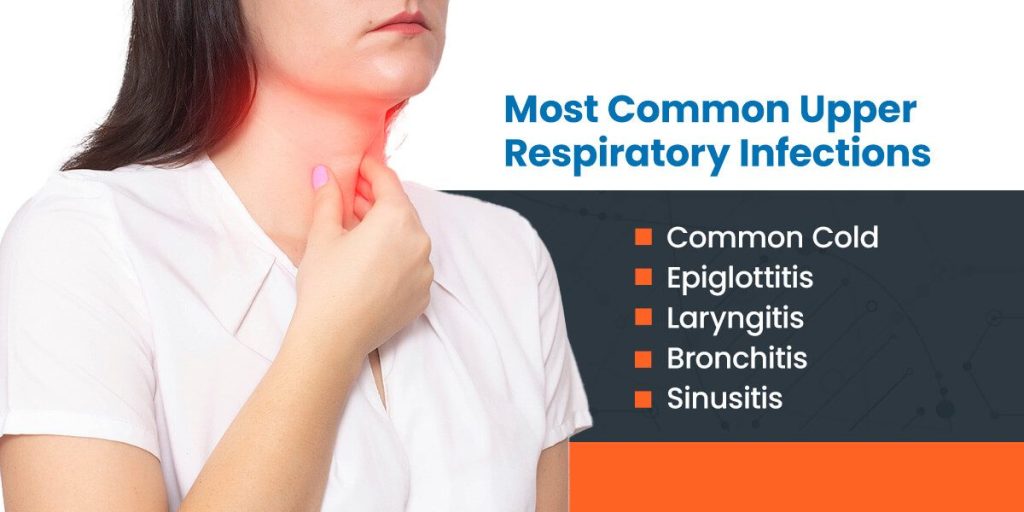Upper respiratory infections (URI) affect individuals of all ages globally. Various microorganisms, including viral and bacterial pathogens, can cause these infections. Medical professionals are tasked with accurately identifying the etiology of these infections to provide appropriate and effective treatment.
What Causes Upper Respiratory Infections?
Upper respiratory infections occur when pathogenic microorganisms enter the body. These pathogens begin to multiply in the nose, sinuses, larynx, pharynx, and large airways, or the upper respiratory tract. The etiology of URIs falls into two categories — viral and bacterial.
Viral Pathogens
Viral pathogens are the typical cause of upper respiratory infections across age groups. These microorganisms are highly contagious and spread through contact with contaminated particulates. Common viral pathogens that cause respiratory infections include:
- Rhinovirus
- Adenovirus
- Enterovirus
- Parainfluenza
- Respiratory syncytial virus (RSV)
Rhinoviruses are one of the predominant etiological agents responsible for upper respiratory infections in pediatric and adult populations. While adults tend to contract a rhinovirus infection annually, children may experience at least two occurrences per year.
Bacterial Pathogens
Bacterial pathogens causing a respiratory tract infection are less common than viral infections. Like viral pathogens, these microorganisms often spread through respiratory droplets. Typical pathogens responsible for these infections include:
- Group A beta-hemolytic streptococci
- Group C beta hemolytic streptococci
- Mycoplasma pneumoniae
- Haemophilus influenzae
Occasionally, a bacterial superinfection may ensue following a viral infection, as the individual’s immune system is in a compromised state. This scenario presents a diagnostic challenge for healthcare professionals, as the initial viral infection can progress into a secondary bacterial infection, often manifesting with similar symptoms.
Upper Respiratory Infection Symptoms
Upper respiratory infections display a variety of clinical signs and symptoms. The presentation may differ from person to person, as some individuals may exhibit only a few of these symptoms, while others may present with all of them. These clinical features include:
- Cough: Microorganisms living in the throat cause irritation that initiates coughing, the body’s natural response to throat irritants. By coughing, the body attempts to expel the irritant.
- Sore throat: Infectious pathogens cause an influx of leukocytes — inflammatory cells. This inflammation can cause swelling in the throat that leads to soreness. Excessive coughing also inflames the throat.
- Hoarse voice: A constant cough and sore throat may cause hoarseness.
- Nasal congestion: With increased inflammatory cells, the nasal passageways swell and cause congestion.
- Rhinorrhea orrunny nose: As the body tries to eliminate the pathogens from the upper respiratory tract, it expels the organisms by increasing mucus production. Leukocytes engaged in combating the infection are also expelled through this nasal discharge.
- Headache: Fluid build-up and congestion in the sinuses can cause increased pressure and inflammation.
- Fever:The immune system raises body temperature to create a less inhabitable environment for pathogens, resulting in a low-grade fever. Protracted infections may lead to higher fevers that require immediate medical attention.
- Fatigue: When fighting an infection, the body needs more recovery time than usual. Feelings of fatigue encourage sleep to aid the immune system response.
- Swollen lymph nodes: As the immune system ramps up blood cell production to combat infection, these cells accumulate in the lymph nodes. This increase in cell production results in increased pressure and swelling, which can manifest as soreness or pain.
Most Common Upper Respiratory Infections
Viral and bacterial pathogens can cause many types of upper respiratory infections.

Common Cold
The common cold is a viral upper respiratory tract infection, and it’s earned its name due to the high prevalence of this illness. Numerous viruses can cause the common cold, including rhinovirus, RSV, and certain coronaviruses.
Typically, the common cold presents with symptoms such as coughing, a sore throat, and a runny nose. However, some individuals may exhibit a broader range of clinical features. For instance, children are more likely to experience fevers with the common cold compared to adults.
Epiglottitis
Epiglottitis arises when the epiglottis — a small cartilaginous flap covering the trachea — becomes inflamed and impedes airflow to the lungs. This inflammation is frequently attributed to a bacterial infection caused by Haemophilus influenzae type b (Hib), which can also lead to meningitis and pneumonia.
While individuals of any age can develop epiglottitis, it was predominantly observed in children before the implementation of routine Hib vaccinations for infants. The introduction of these vaccines has resulted in a relative increase in cases among adults. Other bacterial pathogens implicated in the etiology of epiglottitis include:
- Streptococcus pneumoniae
- Streptococcus A, B, and C
- Staphylococcus aureus
Common symptoms of this infection are fever, sore throat, and difficulty swallowing. The obstruction of the trachea can also lead to stridor, a high-pitched inspiratory noise. Respiratory distress may arise in cases of severe infection, necessitating prompt medical intervention.
Laryngitis
Laryngitis is an inflammation of the larynx due to an infection. The larynx contains the vocal cords, and the infection leads to inflammation in these mucous membranes. As a result, the vocal cords become swollen, leading to hoarseness and dysphonia.
Acute laryngitis is most commonly caused by a viral pathogen, such as adenovirus, rhinovirus, or parainfluenza. In addition to a sore throat and hoarseness, laryngitis presents with:
- Tickling sensations in the throat
- Dry throat
- Dry cough
Bronchitis
When the mucous membranes lining the bronchial tubes become inflamed, the clinical diagnosis is bronchitis. These bronchial tubes carry air to and from the lungs, and the inflammation can cause shortness of breath. Other clinical features of bronchitis include:
- Cough
- Mucus production
- Chest discomfort
- Low-grade fever and chills
- Fatigue
The majority of acute bronchitis cases are viral infections. Bronchitis is among the top 10 upper respiratory infections in outpatients in the United States, and about 5% of adults experience an episode of acute bronchitis annually.
Sinusitis
Sinusitis is an inflammation of the sinuses that can be caused by viral or bacterial pathogens. Acute sinusitis lasts for four weeks or less and usually starts with a viral infection from adenovirus, rhinovirus, or other common viral pathogens. Chronic sinusitis typically results from bacterial pathogens, such as staphylococcus aureus, and lasts for 12 weeks or more. Bacterial sinusitis may even follow viral sinusitis.
Sinus infections present with many symptoms, including:
- Postnasal drip
- Runny nose
- Facial pressure around the eyes, nose, and forehead
- Ear pressure
- Cough
- Headaches
- Fever
- Fatigue
Many people experience sinus infections after another type of URI, like the common cold. Nasal polyps, seasonal allergies, and a deviated septum can increase the risk of contracting sinusitis.

Diagnose Upper Respiratory Infections With Applied BioCode Inc.
The Applied BioCode® Respiratory Pathogen Panel can detect and amplify 17 different targets responsible for respiratory infections. With the BioCode® MDx-3000, medical professionals can process up to 96 samples at once for high throughput. The BioCode® Respiratory Pathogen Panel is US FDA 510(k) cleared in the US and CE Mark in Europe.
This accurate testing method enables medical professionals to identify when viral or bacterial pathogens are present. This distinction is the difference between managing symptoms with over-the-counter medications or requiring prescribed antibiotics.
Confidently select treatments for respiratory infections with Applied BioCode Inc. Contact us today for more information.


